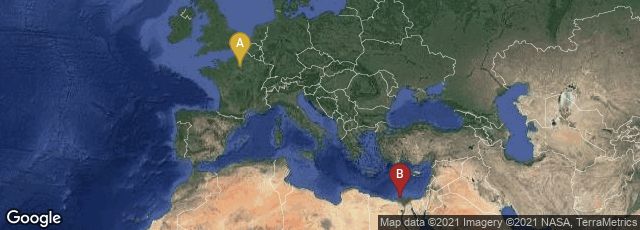
A: Paris, Île-de-France, France, B: El Beheira Governorate, Egypt
Having studied the three texts on the Rosetta Stone, as well as other texts brought back from Egypt from Napoleon's Egyptian campaigns, on September 22, 1882 French scholar, philologist and linguist Jean-François Champollion announced his depherment of Egyptian hieroglyphs in a report to Bon-Joseph Dacier, Perpetual Secretary of the Académie des Inscriptions et Belles Lettres. This was published in Paris as Lettre à M. d'Acier relative à l'alphabet des hiéroglyphes phonétiques. In this 55-page report read to the Académie on September 27,
"Champollion described the alphabet that was used to write non-Egyptian names, and in the concluding pages he tentatively announced that he was certain that the phonetic signs were an integral part of 'pure hieroglyphic writing'. Among the select audience was the great Prussian natural scientist and explorer Alexander von Humboldt (1769-1859) and also Thomas Young, whose initial reaction is recorded in a letter written to W.R. Hamilton on the Sunday after the reading:
" 'I have found here, or rather recovered, Mr. Champollion, junior, who has been living for these ten years on the Inscription of Rosetta, and who has lately been making some steps in Egyptian literature, which really appear to be gigantic. It may be said that he found the key in England which has opened the gate for him, and it is often observed that c'est le premier pas qui coûte [it's the first step that takes the effort]: but if he did borrow an English key, the lock was so dreadfully rusty, that no common arm would ahve strength enough to turn it. . . .' (Parkinson, The Rosetta Stone [2005] 43-44).
Two years after his preliminary report of the discovery Champollion published a fuller exposition as Précis du système hiéroglyphique des anciens égyptiennes, marking the decisive step in the decipherment of Egyptian hieroglyphs.
"His decipherment opened up the millennia of human history and resolved the pharaonic chronology that had been a major concern of the period. It also showed that human history went back much further than was accepted in the Church's chronology based on the Bible" (Parkinson, op. cit., 45).
(This entry was last revised on 08-04-2014).